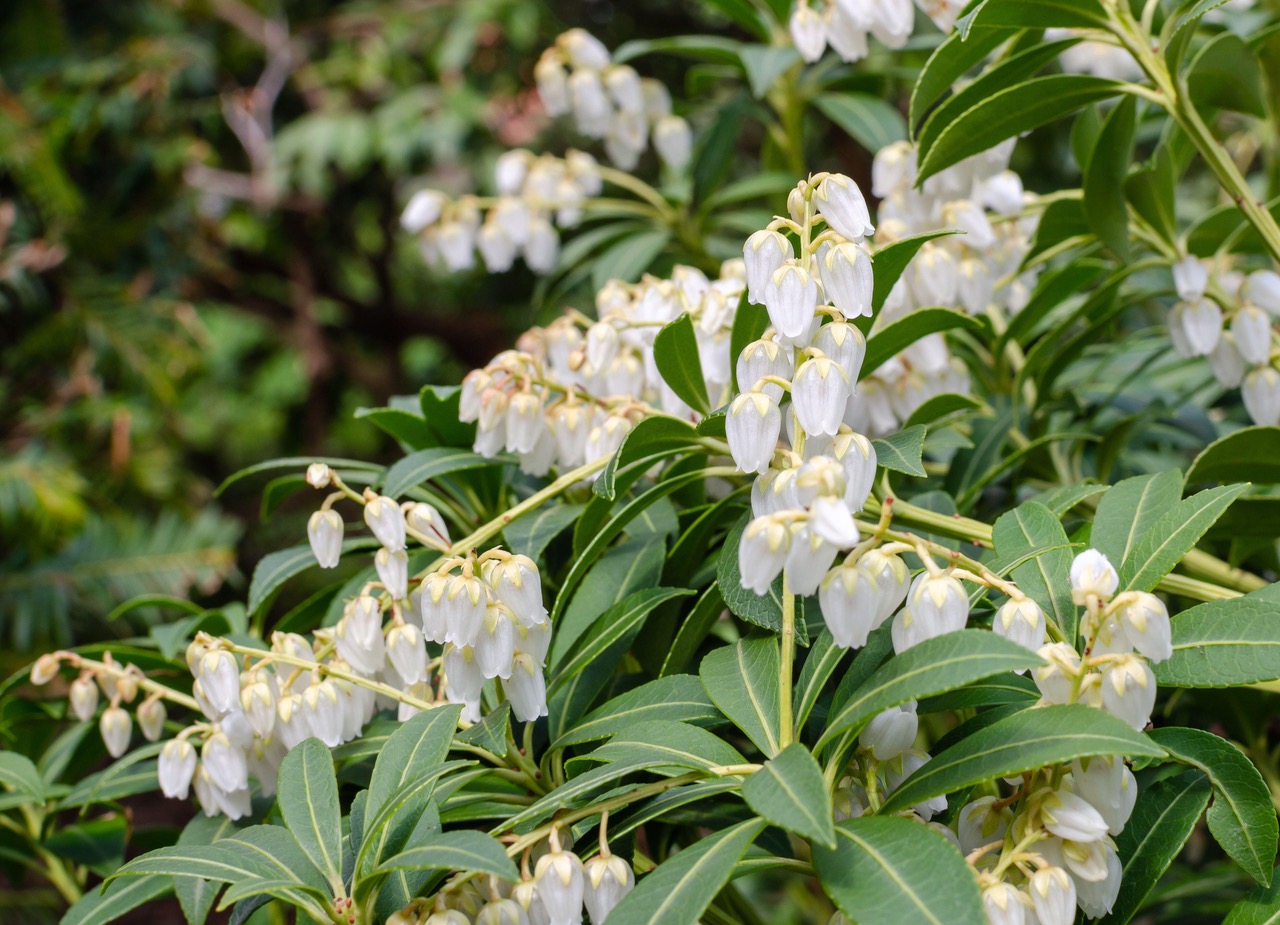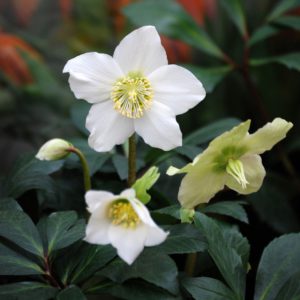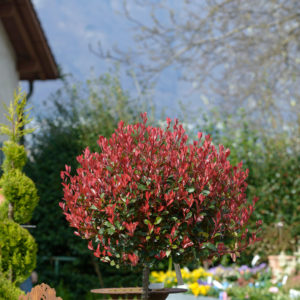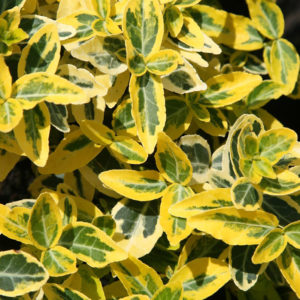Pieris jap. ‘white cascade’
€22.00
Frequently Bought Together

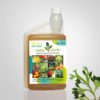
Description
Quick Facts
- Common Name: White Cascade Japanese Pieris, Lily-of-the-Valley Shrub
- Botanical Name: Pieris japonica ‘White Cascade’
- Plant Type: Evergreen shrub
- Mature Height: 1.5-2m
- Mature Spread: 1.2-1.5m
- Flowering Period: March to April
- Flower Colour: Pure white bell-shaped flowers in exceptionally long pendulous clusters
- Foliage: Glossy dark green leaves; bronze-red new growth in spring
- Hardiness: RHS H5 (hardy)
- Soil Requirements: Moist, well-drained, acidic (ericaceous)
- Aspect: Partial shade to full sun (with shelter)
- Maintenance: Low to moderate
Description
____________________________________________________________________________________________________________________
Experience the breathtaking beauty of Pieris japonica ‘White Cascade’, the spectacular Japanese Pieris that brings exceptional spring drama, cascading elegance, and year-round structure to gardens with its extraordinarily long white flower clusters and colourful new growth. This outstanding evergreen shrub offers remarkable qualities—masses of pure white bell-shaped flowers in exceptionally long graceful pendulous clusters measuring 15-20cm long (sometimes up to 25cm) creating dramatic cascading displays that are among the longest of any pieris cultivar in early spring when few other shrubs bloom, bronze-red new growth emerging in spring creating beautiful contrast against the white flowers and dark green mature foliage, upright elegant habit with arching branches that showcase the cascading flowers to perfection, and glossy dark green evergreen foliage providing year-round structure and elegant presence, making this one of the finest and most spectacular pieris for creating spring drama, cascading flower displays, and year-round beauty in gardens.
Throughout spring, this captivating shrub displays its most spectacular features—masses of pure white bell-shaped flowers measuring 6-8mm long arranged in exceptionally long graceful pendulous clusters (racemes) measuring 15-20cm long (sometimes up to 25cm—among the longest of any pieris) that cascade from the branch tips like elegant waterfalls or strings of tiny bells, creating dramatic displays. The flowers have a delicate waxy texture and subtle sweet fragrance. The extraordinary length of the flower clusters is the defining feature of ‘White Cascade’—the cascading effect is far more pronounced than standard pieris cultivars, creating stunning visual impact. As the flowers bloom, the new spring growth emerges in attractive bronze-red tones creating beautiful contrast against the pure white flowers and the glossy dark green mature foliage. The bronze-red new growth gradually matures through shades of bronze-pink to glossy dark green over several weeks, extending the colour display. The mature leaves measure 6-9cm long with finely serrated edges and a leathery texture, creating dense evergreen coverage. The overall effect is elegant, dramatic, and refined. The upright habit with gracefully arching branches creates elegant form that showcases the cascading flowers beautifully—the branches bow under the weight of the long flower clusters creating natural grace.
Native to Japan, Pieris japonica has been cultivated in Western gardens since the 19th century and is beloved for its spring flowers and colourful new growth. The genus name Pieris comes from the Pierides, the nine Muses of Greek mythology, while ‘japonica’ refers to its Japanese origins. The cultivar name ‘White Cascade’ perfectly describes its most distinctive feature—the exceptionally long white flower clusters that cascade like waterfalls. This cultivar was selected specifically for its extraordinary flower length and dramatic cascading effect. Hardy and adaptable, this pieris thrives in temperate climates with cool moist conditions, particularly suited to gardens with acidic soil. Requires acidic (ericaceous) soil—will not thrive in alkaline or chalky conditions. Prefers sheltered positions protected from cold drying winds and early morning sun which can damage flowers and new growth after frost. Moderate growth rate, establishing within 3-5 years and producing reliable spectacular spring displays. The medium size and elegant habit make this ideal for medium to large gardens, mixed borders, and woodland gardens.
Create stunning compositions by planting as spectacular specimen shrubs in mixed borders, woodland gardens, or foundation plantings where the exceptionally long cascading flowers, bronze-red new growth, and elegant form can be fully appreciated and viewed from multiple angles. Exceptional in woodland gardens, shade gardens, or beneath deciduous trees where the dappled shade and acidic soil provide ideal conditions and the cascading flowers create magical displays. Works beautifully planted with other ericaceous plants (rhododendrons, azaleas, camellias, heathers) that share soil requirements, or with spring bulbs (daffodils, bluebells) and shade-tolerant perennials (hostas, ferns, hellebores) that complement the spring display. Magnificent in Japanese-style gardens where the elegant cascading form and spring beauty create authentic character. Perfect for positions near pathways, seating areas, or viewed from windows where the dramatic cascading flowers can be admired up close. Ideal for creating spectacular spring drama, cascading elegance, and year-round evergreen structure in gardens with acidic soil.
Caragh Garden Notebook
____________________________________________________________________________________________________________________
Planting: Space shrubs 1.5-2m apart for mass plantings, or allow 2-2.5m for specimen placement to accommodate the mature spread and showcase the cascading flowers. Plant container-grown specimens year-round, though autumn or early spring is ideal. Dig holes twice the width of the root ball and incorporate generous amounts of ericaceous compost or peat-free acidic organic matter. Plant at the same depth as the container—avoid planting too deeply. Water thoroughly with rainwater if possible (tap water can be alkaline). Mulch generously with acidic organic matter (pine needles, composted bark, leaf mould). Choose positions in partial shade to full sun with shelter from cold winds and early morning sun—dappled shade under deciduous trees is ideal. Position where the cascading flowers can be viewed and appreciated. CRITICAL: Requires acidic soil—will not thrive in alkaline or chalky conditions. Ideal for woodland gardens, shade gardens, and ericaceous borders.
Soil Preparation: CRITICAL: Requires moist, well-drained, acidic soil with pH 4.5-6.0. Will not tolerate alkaline, chalky, or neutral soils—leaves will turn yellow (chlorosis) and the plant will decline. If your soil is not naturally acidic, create raised beds filled with ericaceous compost. Prefers rich, moisture-retentive, humus-rich conditions similar to woodland floor. Incorporate generous amounts of ericaceous compost, composted bark, or peat-free acidic organic matter. Dislikes waterlogged or dry soils. Best growth and flowering occur in partial shade with moist, well-drained, acidic soil enriched with organic matter and consistent moisture—these conditions produce the longest, most spectacular flower clusters.
Container Growing: Suitable for container growing in large pots (minimum 50-60cm diameter due to the larger size) using ericaceous (acidic) compost, though the medium size means this is better suited to in-ground planting where the cascading flowers and elegant form can develop fully. CRITICAL: Use only ericaceous compost—never use standard multi-purpose compost. Water regularly with rainwater if possible (tap water in hard-water areas is alkaline and will cause chlorosis over time). Keep compost consistently moist but not waterlogged. Feed in spring after flowering with ericaceous fertiliser. Mulch surface with acidic organic matter. Repot every 2-3 years in spring using fresh ericaceous compost. In-ground planting is preferred for best growth and flower display.
Seasonal Care: Requires minimal pruning—the naturally elegant upright form with arching branches develops without intervention. Deadhead spent flower clusters after blooming if desired to tidy appearance, though this is not essential. If light shaping is needed, prune immediately after flowering (April-May) before new growth hardens—avoid pruning later as this removes next year’s flower buds which form on current season’s growth. Remove any dead or damaged branches. Apply ericaceous fertiliser in spring after flowering to support new growth and next year’s flower production. Mulch annually with acidic organic matter (pine needles, composted bark). Water regularly during dry spells using rainwater if possible—consistent moisture is important, especially during flowering and when new growth is developing, and supports the development of the exceptionally long flower clusters. Protect from cold drying winds and early morning sun after frost which can damage flowers and tender new growth. Watch for lace bugs (cause mottled leaves—spray with insecticidal soap) and leaf spot diseases (improve air circulation). Generally trouble-free with proper acidic soil and consistent moisture. The spring display is reliably spectacular and dramatic!
Propagation: Can be propagated from semi-hardwood cuttings in late summer with rooting hormone and ericaceous compost—success rate is moderate. Take cuttings 8-10cm long from current season’s growth, remove lower leaves, dip in rooting hormone, and insert in pots of ericaceous compost and grit mix. Keep moist, shaded, and cool until rooted (8-12 weeks). Pot on using ericaceous compost. Home gardeners can propagate this cultivar, though nursery-grown specimens provide more immediate impact and guaranteed flowering size with the characteristic long cascading flower clusters.
____________________________________________________________________________________________________________________
This spectacular beauty is absolutely breathtaking—one of the most dramatic pieris cultivars available! Those exceptionally long cascading white flower clusters measuring 15-20cm (sometimes up to 25cm!) are absolutely stunning—among the longest of any pieris creating waterfall-like displays! Pure white bell-shaped flowers in early spring, beautiful bronze-red new growth creating lovely contrast, elegant upright habit with arching branches that showcase those cascading flowers to perfection. Glossy dark green evergreen foliage provides year-round structure. Hardy and reliable flowering. CRITICAL: requires acidic soil—won’t thrive in alkaline or chalky conditions, so use ericaceous compost and rainwater. Perfect for woodland gardens, shade borders, and anywhere with acidic soil where you want truly spectacular cascading spring drama. Pure spring magnificence and dramatic elegance!

